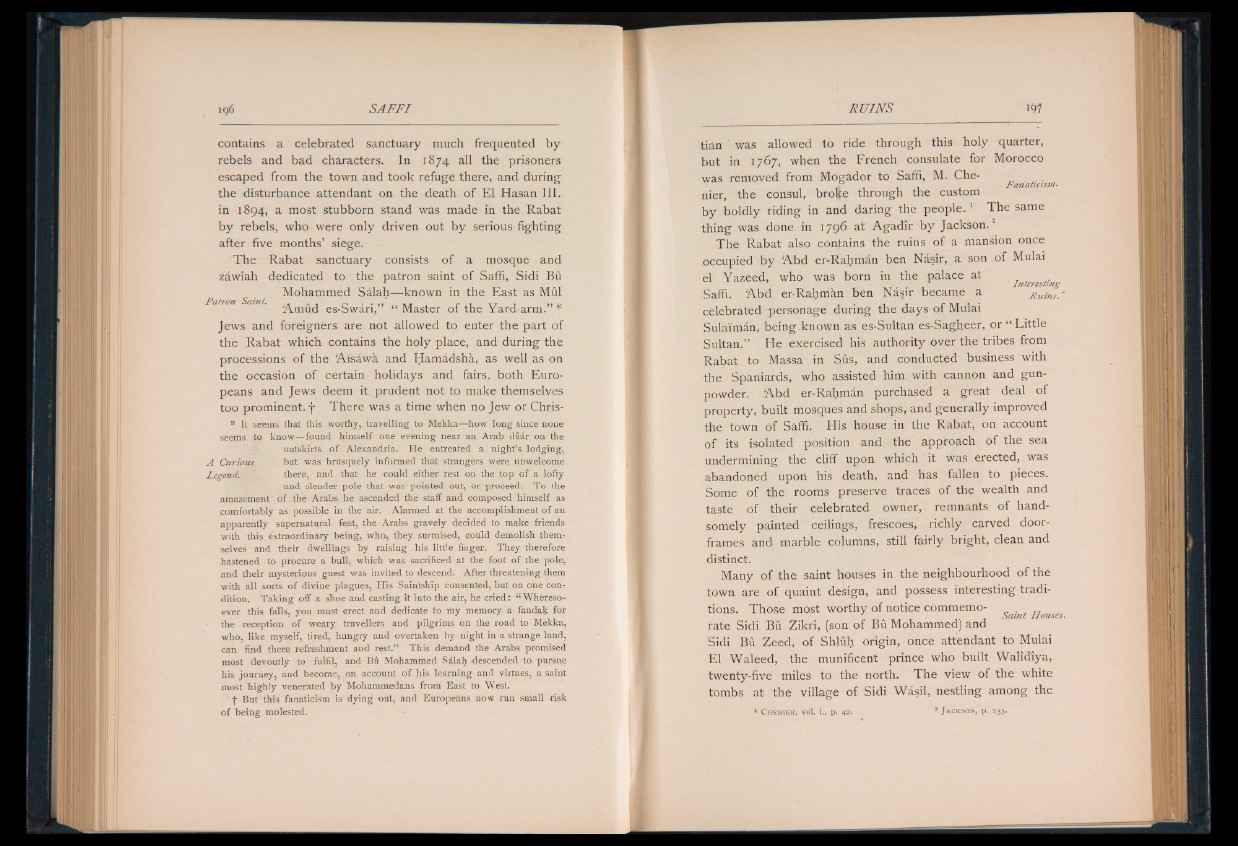
contains a celebrated sanctuary much frequented by
rebels and bad characters. In 1874 all the prisoners
escaped from the town and took refuge there, and during
the disturbance attendant on the death of El Hasan III.
in 1894, a most stubborn stand was made in the Rabat
by rebels, who were only driven out by serious fighting
after five months’ siege.
The Rabat sanctuary consists of a mosque and
zawiah dedicated to the patron saint of Saffi, Sidi Bu
Mohammed Salah— known in the East as Mul
Patron Saint. ’ A _1 ~ _ , _r . ^
Amud es-Swari, “ Master 01 the Yard arm. *
Jews and foreigners are not allowed to enter the part of
the Rabat which contains the holy place, and during the
processions of the Aisawa and Hamadsha, as well as on
the occasion of certain holidays and fairs, both Europeans
and Jews deem it prudent not to make themselves
too prominent, f There was a time when no Jew or Chris-
* It seems that this worthy, travelling to Mekka—how long since none
seems to know—found himself one evening near an Arab du£r on the
outskirts of Alexandria. He entreated a night’s lodging,
A Curious but was brusquely informed that strangers were unwelcome
Legend. there, and that he could either rest on the top of a lofty
and slender pole that was pointed out, or proceed. To the
amazement of the Arabs he ascended the staff and composed himself as
comfortably as possible in the air. Alarmed at the accomplishment of an
apparently supernatural feat, the Arabs gravely decided to make friends
with this extraordinary being, who, they surmised, could demolish themselves
and their dwellings by raising his little finger. They therefore
hastened to procure a bull, which was sacrificed at the foot of the pole,
and their mysterious guest was invited to descend. After threatening them
with all sorts of divine plagues, His Saintship consented, but on one condition.
Taking off a shoe and casting it into the air, he cried: “ Wheresoever
this falls, you must erect and dedicate to my memory a fandak for
the reception of weary travellers and pilgrims on the road to Mekka,
who, like myself, tired, hungry and overtaken by night in a strange land,
can find there refreshment and rest.” This demand the Arabs promised
most devoutly to fulfil, and Bu Mohammed Salah descended to pursue
his journey, and become, on account of his learning and virtues, a saint
most highly venerated by Mohammedans from East to West.
f But this fanaticism is dying out, and Europeans now run small risk
of being molested.
tian was allowed to ride through this holy quarter,
but in 1767, when the French consulate for Morocco
was removed from Mogador to Saffi, M. Che-
F . I Fanaticismnier,
the consul, broke through the custom
by boldly riding in and daring the people. 1 The same
thing was done in 1796 at Agadir by Jackson.2
The Rabat also contains the ruins of a mansion once
occupied by Abd er-Rahman ben Nasir, a son of Mulai
el Yazeed, who was born in the palace at
7 / . 1 Interesting
Saffi. Abd er-Rahman ben Nasir became a R u in s.'
celebrated personage during the days of Mulai
Sulaiman, being.known as es-Sultan es-Sagheer, or “ Little
Sultan.” He exercised his authority over the tribes from
Rabat to Massa in Sus, and conducted business with
the Spaniards, who assisted him with cannon and gunpowder.
Abd er-Rahman purchased a great deal of
property, built mosques and shops, and generally improved
the town of Saffi. His house in the Rabat, on account
of its isolated position and the approach of the sea
undermining the cliff upon which it was erected, was
abandoned upon his death, and has fallen to pieces.
Some of the rooms preserve traces of the wealth and
taste of their celebrated owner, remnants of handsomely
painted ceilings, frescoes, richly carved doorframes
and marble columns, still fairly bright, clean and
distinct.
Many of the saint houses in the neighbourhood of the
town are of quaint design, and possess interesting traditions.
Those most worthy of notice commemo- J Saint Houses.
rate Sidi Bu Zikri, (son of Bu Mohammed) and
Sidi Bu Zeed, of Shluh origin, once attendant to Mulai
El Waleed, the munificent prince who built Walidiy-a,
twenty-five miles to the north. The view of the white
tombs at the village of Sidi Wasil, nestling among the